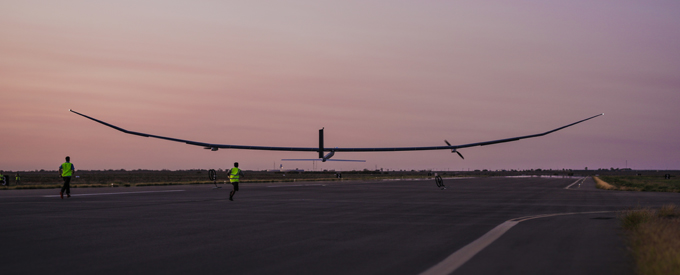2020-03-01
Going the Distance With Solar Powered UAS
Recently, PHASA-35 (Persistent High-Altitude Solar Aircraft), a 35m wingspan solar-electric aircraft, successfully completed its maiden flight. The flight paves the way for this new aircraft to become a game changer in the air and space market, plugging the gap between aircraft and satellite technology.
The aircraft has been designed, built and now flown in less than two years as part of a collaboration between BAE Systems and Prismatic Ltd, which BAE Systems acquired last year. Designed to operate unmanned in the stratosphere, above the weather and conventional air traffic, PHASA-35 offers a persistent and affordable alternative to satellites combined with the flexibility of an aircraft, which could be used for a range of valuable applications including forest fire detection and maritime surveillance.
The technology would offer a year-round, persistent service for a wide range of needs including surveillance and vital communications to remote areas, using only the Sun to power the aircraft during the day and recharge the batteries for overnight operation.
Solar High-Altitude Long Endurance (HALE) vehicles offer a significantly affordable alternative to conventional satellite technology, with PHASA-35 being a concept solar electric UAV that uses proven, long life battery technology and ultra-lightweight solar cells to potentially maintain flight for up to 12 months.
Sponsored by the UK’s Defence Science and Technology Laboratory (DSTL) and Australian Defence Science and Technology Group (DSTG), the successful flight trials took place at the Royal Australian Air Force (RAAF) Woomera Test Range in South Australia.
The trials marked the first fully integrated flight test of the PHASA-35 system, delivering rapid proof of capability from design to flight in just 20 months. They are the culmination of efforts from a collaborative team of British experts from Prismatic in Hampshire, where two full-sized concept aircraft were built last year, working alongside BAE Systems engineers in Lancashire, where the aircraft underwent further integration testing prior to flight trials.
Persistent Platform
PHASA-35 is designed to provide a persistent, stable platform for monitoring, surveillance, communications and security applications. When connected to other technologies and assets, it will provide both military and commercial customers with capabilities that are not currently available from existing air and space platforms. The Unmanned Air Vehicle also has the potential to be used in the delivery of communications networks including 5G, as well as provide other services, such as disaster relief and border protection, at a fraction of the cost of satellites.
Ian Muldowney, Engineering Director for BAE Systems, said: “This is an outstanding early result that demonstrates the pace that can be achieved when we bring the best of British capability together. To go from design to flight in less than two years shows that we can rise to the challenge the UK Government has set industry to deliver a Future Combat Air System within the next decade.”
BAE Systems’ acquisition of Prismatic forms part of the Company’s strategy to develop breakthrough technologies, making acquisitions where they complement existing capabilities and provide an opportunity to accelerate technology development in key areas.
“Prismatic is a fast paced and forward-thinking company and PHASA-35 is a great example of what the team can achieve in a short space of time. We were keen to invest in the programme as part of our long-term strategy to explore new technologies and solutions in air and space. I look forward to working with the team and I’m sure the collaboration will add further strength to both ourselves and Prismatic,” says Michael Christie, Strategy Director within BAE Systems’ Air sector
“PHASA-35 has the ability to revolutionise the way we think about Beyond Line of Site communications. It’s great to have the support of a world-leading technology company like BAE Systems. I’d like to extend a huge thank you to the team who have worked tirelessly over the past two years to develop PHASA-35 as a proven, cost effective and reliable system,” said Paul Brooks, Founder and Managing Director of Prismatic Ltd.
Further flight trials are scheduled for later this year, with the possibility that the aircraft could enter initial operations with customers within 12 months of the flight trials programme completion.
BAE Systems has a portfolio of patents and patent applications covering approximately 2,000 inventions internationally, and under the agreement with Prismatic, it will provide expertise in aerospace technology and project management to progress the PHASA-35 programme through to a marketable offering.
Reference Text/Photo:


No Comments